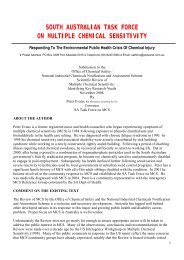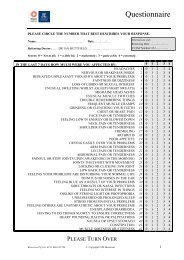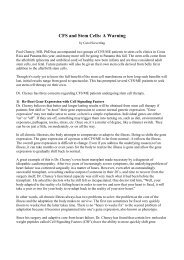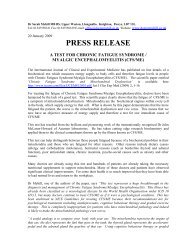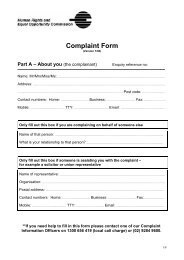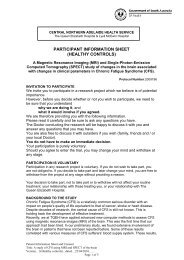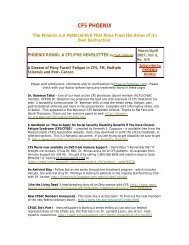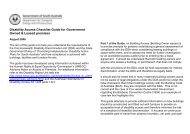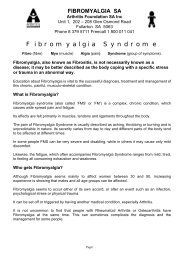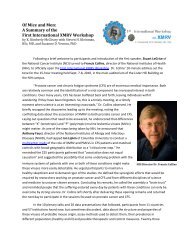60 R. Casale et al.cal exercise and other therapies that are used infancy and pseudophilosophical ways, and it rendersevaluation of possible positive results nearly impossiblein the absence of a defined diagnosis andrecognised treatment protocols.The second onion layer is related to the possiblepresence of FM subset as well as to the erratic presentationof multiple painful muscle spots and correlatedsymptoms (1).A third layer recognizes the presence of different approachto management objectives and treatmentchoices by the various medical professionals involvedin the treatment of FM. For instance occupationaltherapists consider an increasing level of activityas the major treatment objective, followed bypain control and fatigue management while physicaltherapists are more concerned with improvingexercise tolerance and fitness followed by pain controland functional abilities. Fatigue managementand endurance exercise are the most frequent interventionaltargets across both professions (2).The last and most important layer addresses thepresence of a neuropathic component in the manifestationof pain in FM. In other words, if the painexpression in FM is only due to nociceptive pain(peripheral and related to an activation in musclenociceptors), or if the pain felt by FM patients intheir muscle is more or less dependent on functionalalteration in the sensory decoding of afferentinputs as well as in altered descending paincontrol systems. These last theories have gainedstrength recently based on several studies as wellas clinical reports (see other chapters in this issue).This is the most important point to keep in mindwhen prescribing non pharmacological treatmentsin FM, as the two types of pain, namely neuropathicand nociceptive, require different non pharmacologicalapproaches (3). Unfortunately, thisconcept is rarely considered when tailoring nonpharmacological treatments for pain control, ingeneral, and particularly, in FM. This oversight canresult in inappropriate application of otherwise usefulnon pharmacological pain control techniques..For the sake of systematic organization, the mostcommonly used forms of non pharmacologicaltreatment in FM can be divided into four majorcategories:- Physical therapies- Movement and exercises.- Cognitive-behavioural treatments.- Complementary and alternative treatments.Of note, the majority of non pharmacological treatmentstudies utilise multimodal therapies, whichrenders comparison and critical analysis on the efficacyof a single treatment difficult and a possibleguideline on these techniques a source of majorcriticism.PHYSICAL THERAPIESThe definition of physical therapies encompassesall treatment using a physical activity or techniqueto induce some therapeutic effect. These techniquesare mainly used in a rehabilitation context, althoughsome are also used as complementary andalternative treatments. These two approaches arequite divergent, however. In the rehabilitation context,physical therapies are used on the basis oftheir ascertained mechanism of action (i.e., the activationof the spinal gate, release of endogenousopiates, local metabolic action, etc.), but when usedas alternative treatments this linkage is completelylost.Physical therapies include thermal (both heat andcold), mechanical, light, electrical and magneticstimulation. In this context, acupuncture as well asmechanical stimulation that is induced by someform of massage (i.e. connective tissue massage)can be considered as particular forms of physicaltreatment. Each technique claims its own mechanismof action, although peer-reviewed evidence oftheir effectiveness in FM is lacking and recent reviewshave reached non homogeneous conclusions.While some reviews, based only on few randomized,controlled trials, are cautious in stating efficacy,they strongly suggest conducting more soundstudies and demonstrating a long-term, effectiveintervention for managing the symptoms associatedwith FM (4). Other reviews, which have includedanecdotal evidence or small, observationalphysiotherapy studies, indicate that physical therapiescan be efficacious for different symptoms (5).Heat and coldAlthough beneficial in other forms of muscle pain,local application of cold therapy by means of icecubes or cooling sprays does not seem to have anyefficacy in FM. Cold sprays are used within thestretch and spray techniques (see below). On thecontrary whole body criotherapy at -67°C seems tohave some short-term effect on the number of activetrigger points and intensity of pain. No data areavailable on its long-term efficacy (6). Superficialheat and deep heat with infrared and ultrasound applicationas well as the local thermal effect induced
Non pharmacological treatments in fibromyalgia 61by stroking massages have been always reported asbeneficial by FM patients (7, 8). When deep heathas been compared with sertraline, an antidepressant,it fails to show any better results (9). Heat isalso a fundamental factor in balneotherapy (see below).The real efficacy of both superficial as well asdeep heat is still matter for research, however.Electrical stimulation & TENSElectrical currents are, by far, the most used physicaltherapy in pain medicine. In fibromyalgia theyhave been applied transcutaneously to stimulateperipheral nerves (TENS) (10, 11) as well as totranscranially to stimulate cortical areas of the brain(12). Stimulation of motor cortex areas is betterachieved through magnetic stimulation. Preliminarybut encouraging results have been obtained bythis newly introduced methodology (13, 14). Traditionalelectrical currents have been used at highand low intensity (12) as well as at high and lowfrequency (10, 11) and by applying interferentialpatterns (7). Hydrogalvanic baths have historicalmerit, although they are evidently still in use withsome success in treating pain (15). One review articlequotes TENS as a useful methodology to controlspecific symptoms such as localised musculoskeletalpain (5) while a more recent review ismore cautious on the general efficacy of electricalcurrent (4). What can be said is that TENS and relatedtechniques can be beneficial in treating specific,contingent and localized pain problems whilethey do not have any sort of effect on FM as awhole. This concept is extensible to most of the nonpharmacological treatments considered in this review.Laser LightFew and conflicting data are available on the useof LASER in FM although a possible mechanismbasedefficacy has been demonstrated (16). Somestudies have reported no effects (17, 18) while othershave found a statistically significant reductionin both spontaneous and mechanically evoked pain(19, 20). Comparison of various treatment protocolsis difficult, however, due to varying lengths ofemission wave and emission power across different,non-standardised protocols. Moreover almostall studies that employed laser treatment used lowpower laser that cannot reach deep muscle layerswhere taught band and trigger points are usually located.As far as we know only one study has used lightbathing (exposure to a source of with light) as atherapy; however, results in FM patients did not differfrom those in the placebo group (21).MassageThe efficacy of massage varies depending on thetype and intensity of mechanical stimulation exerted.Connective tissue massage is a techniquethat applies mechanical stimulation of varying intensityin a predetermined pattern rather than followingthe trigger point sites identified by the patient.This technique uses two different stimulationintensities, and the mechanism of action relies ongate control as well as on the release of endogenousopiates. Connective tissue massage has been shownto improve pain and reduce the number of triggerpoints (22-24) while other forms of massage, i.e.,relaxation massages, only result in a general sensationof pleasantness and wellness (25); althoughthis is very much appreciated by patients (26, 27),it does not reflect a clinical improvement. Relaxationmassage, therefore, is more appropriately designatedas an alternative treatment than a physicaltherapy.AcupunctureIn single clinical trials acupuncture shows interestingresults (28, 29) that are confirmed by systematicreviews (30). Acupuncture has been shown notonly to decrease the number and intensity of painfulspots but also to modify neuro-hormonal parametersin these patients (29). It is worth noting thatsome FM patients do not like the acupuncture sensation;and in some cases, exacerbation of symptomshas been reported, which confirms the clinicalobservations of the extreme instability of thesensory-reaction system in these patients (30, 31).Dry needling is a form of acupuncture performedwith normal needles that are usually used for injectedtherapies (28 gauge). Dry needling of triggerpoints seems to have some long lasting effecton trigger-point pain in nearly 30% of patients (32);this may be due to activation of the endogenousopioid system as its analgesic effect is reversed bynaloxone. A systematic review and meta-analysisof randomised controlled trials on dry needling andacupuncture in the management of myofascial triggerpoint pain has been published recently and focuseson the substantial need for more extensive,controlled studies (33).BalneotherapyThermal therapy is one of the oldest treatmentmodalities for osteoarthropathies. Historically, the
- Page 2 and 3:
2 P. Sarzi-Puttini et al.The meetin
- Page 4 and 5:
4 M. Cazzola et al.(2). In the earl
- Page 6 and 7:
6 M. Cazzola et al.enough to meet F
- Page 8 and 9:
8 M. Cazzola et al.Table I - Charac
- Page 10 and 11: 10 M. Cazzola et al.Table IV - Cond
- Page 12 and 13: 12 M. Cazzola et al.teria, three su
- Page 14 and 15: 14 M. Cazzola et al.tients with a n
- Page 16 and 17: 16 G. Cassisi et al.The cardinal fe
- Page 18 and 19: 18 G. Cassisi et al.StiffnessIn FM
- Page 20 and 21: 20 G. Cassisi et al.Autonomic and n
- Page 22 and 23: 22 G. Cassisi et al.Associated symp
- Page 24 and 25: 24 G. Cassisi et al.46. Coleman RM,
- Page 26 and 27: 26 S. Stisi et al.sensitization,”
- Page 28 and 29: 28 S. Stisi et al.Sum oflife-events
- Page 30 and 31: 30 S. Stisi et al.trols, they prese
- Page 32 and 33: 32 S. Stisi et al.stress, obtained,
- Page 34 and 35: 34 S. Stisi et al.50. Harris RE, Cl
- Page 36 and 37: ORIGINAL ARTICLEReumatismo, 2008; 6
- Page 38 and 39: 38 F. Atzeni et al.lalanine (17), a
- Page 40 and 41: 40 F. Atzeni et al.clearer and it m
- Page 42 and 43: 42 F. Atzeni et al.healthy control
- Page 44 and 45: 44 F. Atzeni et al.and/or verbal (e
- Page 46 and 47: 46 F. Atzeni et al.for study purpos
- Page 48 and 49: 48 F. Atzeni et al.mimics of fibrom
- Page 50 and 51: ORIGINAL ARTICLEReumatismo, 2008; 6
- Page 52 and 53: 52 P. Sarzi-Puttini et al.A larger
- Page 54 and 55: 54 P. Sarzi-Puttini et al.from 1966
- Page 56 and 57: 56 P. Sarzi-Puttini et al.rational,
- Page 58 and 59: 58 P. Sarzi-Puttini et al.49. Toffe
- Page 62 and 63: 62 R. Casale et al.definition of
- Page 64 and 65: 64 R. Casale et al.are more or less
- Page 66 and 67: 66 R. Casale et al.trol associated
- Page 68 and 69: 68 R. Casale et al.32. Lewit K. The
- Page 70 and 71: ORIGINAL ARTICLEReumatismo, 2008; 6
- Page 72 and 73: 72 L. Altomonte et al.In a clinical
- Page 74 and 75: 74 L. Altomonte et al.Table II - We
- Page 76 and 77: 76 L. Altomonte et al.treatments de



